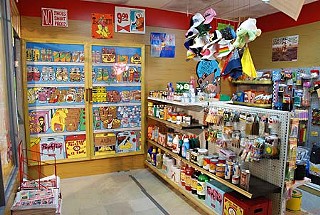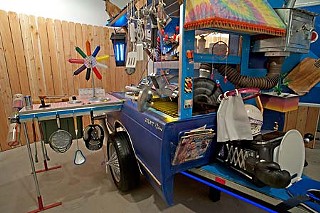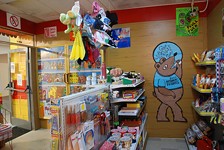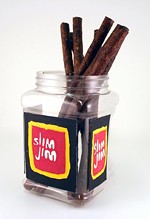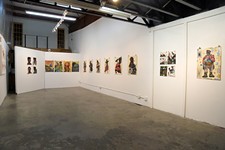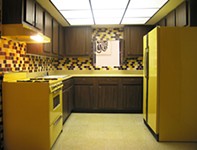Collective Burgeoning
For the artists of Okay Mountain, it was a very good year
By Robert Faires, Fri., Sept. 17, 2010

Over any 12-month period, most of us feel fortunate to claim even one breakthrough on the professional front – a promotion, say, or some new acknowledgment from one's peers. Try to imagine, then, how the artists of the Eastside collective Okay Mountain feel after a year packed with amazing firsts: First showing in an international art fair. First university exhibition. First permanent public mural. First show in a commercial gallery – also, first show in New York. First review in The New York Times. First commission from an art museum. And on top of all that, the group's installation at the Pulse Contemporary Art Fair won both the 2009 Pulse Prize for best emerging artist and the People's Choice Award.
With so much going on, it isn't surprising that the collective was named Artist of the Year at the 2009-2010 Austin Critics Table Awards. But the year was really about Okay Mountain's leap from being a well-regarded local team of gallerists and artmakers to a force on the national art scene. And remarkably, doing it with five projects wildly divergent from one another in subject matter, material, and style: Corner Store, a satirical version of a convenience store, fully stocked with fake products, which was commissioned by Arthouse for Pulse Miami 2009; Big Strange Mystery, an evocation of a natural history museum exhibit replete with a giant skeleton of an imaginary creature, created for Texas State University's Gallery I; Food Fight, a mural painted for the cafeteria at Vanderbilt University; Benefit Plate, a send-up of tailgating trailers, made for the New York gallery Freight + Volume; and Water, Water Everywhere So Let's All Have a Drink, a video collage that riffs on late-night channel surfing, commissioned by the Austin Museum of Art.
Five of the collective's 10 members sat down with the Chronicle to discuss their landmark year. Reviewing it project by project, they reveal not only how the individual works were developed but also how they reflect the group's approach to making art as a collective and how the artists feel about what they've achieved and the attention they've received. The conversation took place Tuesday, Aug. 31, in the Okay Mountain studios.
Getting Started
Austin Chronicle: Did you have any sense that this year was going to be big? Did you feel like you were ramping up to something different?
Sterling Allen: We always think it's like, "Okay, it's happening now." I think we felt like that since we opened our first show. We sold our first drawing for $800, and it was like: "Wow. We've arrived."
AC: Each Okay Mountain project has such a distinct character. How do projects start?
Ryan Hennessee: Most of our big project ideas have come out of sitting around and brainstorming. That's been the most productive way to decide on a project, just because everyone had a chance to throw ideas into this one big thing. That way, everybody has some ownership of the starting point, and that makes it easier to be invested throughout the rest of the project. So you don't feel like you're just doing somebody else's idea. Nobody wants to do that.
Michael Sieben: We try to think of a really loose concept that everybody can get on board with. For the AMOA show, we just started talking about television in a really, really general sense. Then everyone agreed that we could do a show about TV. From there, everyone starts putting in specific ideas, sort of molding what a show about TV is gonna be, whether it's video or sculpture or paintings.
Allen: That's the hardest part, honestly: coming up with that idea. It's not as easy as, "We should do a show about this!" Maybe that's the start, but then there's a ton of arguing and back and forth about why we should proceed with this and what's been done in the past in this vein, or "Are we copying this?" or "This person did it better," or "This is too much like our last project." So just getting from discussion to something concrete, that's the huge challenge of each process. Once it's going, it's easy to make stuff.
Sieben: People work differently, so from the beginning we try not to put hard-line constraints on what you can do. For [the TV project], obviously we had to make videos, but we didn't say it has to be this type of video. Anything that you're interested in or any ideas you want to explore, feel free to do so and make any type of video you want. We try to leave it open so that people can work in any means that they feel comfortable or practices that maybe they would already be doing with their own personal artwork.
Nathan Green: We always trust the fact that every single person is going to be contributing something, so it's always going to be an amalgam of different things fused together instead of coming from one direct tradition or one reference. It's always gonna be this mishmash.
Carlos Rosales-Silva: I think that's what's so great about there being so many of us. We each have our own interests, and we each have our own practices, and they've been informed by completely different things. So we can all bring that to the table and bring the knowledge that we have of other artworks to the table and at the same time reference them, and in the end, maybe you have all these references, but they're so mixed together that it's a completely new thing, a different thing. That's been a really big strength for us.
AC: I assume you like one another's work – it would be pretty hard for a collective to stay together any length of time if you didn't – but do you actively coach or encourage each other?
Rosales-Silva: Absolutely. A huge part of it is checking your ego at the door and being ready to have someone tell you that something doesn't look as good as something else or that something doesn't work or that something doesn't fit. You can't take it personally, because it's all about the project, and it's not about your choices or motivations.
Sieben: Someone's not saying, "I don't like your art." He's saying, "I don't know if what you've done fits into our project exactly, but revisit that." Or, "I could work on it with you." If someone's not quite hitting the mark, someone can step in and go, "I think I know how we can tweak this so it fits in." Then it's like you learn something. I definitely feel like my own personal artwork has greatly benefited from just being around all these people and seeing their studio practices and working on their bigger projects and thinking about stuff outside my studio. I feel like everyone has grown. It's almost like still being in school, where we're doing these projects, and we have to be here and work on stuff.
Allen: And in a critical sense, it's like what school pretends to be. Like you have these crits where nothing's at stake; it's like, "Oh, I feel like your piece is too big," and then you make another project, just for show in a way. People are trying to get better, and the teachers are trying to help you, but there's nothing at stake really. But for this, we're having a really intense critical dialogue. The words "critical dialogue" get thrown around all the time, but it's actually in play here. Because it's a real world thing, and we're talking about real work.
Hennessee: And it's going in an exhibit with all of our names behind it.
Rosales-Silva: We're all very invested in it.
Hennessee: So if half of us think something's not working, we're going to say something. I think everyone is okay with that. Everyone has had stuff cut somewhere along the line.
Green: It's a constant negotiation, too, reassessing where we are, what we need, how everything fits, and negotiating our own things and how they work into the greater good.
Hennessee: It's a learning process that's been different for each project. I think we're still figuring it out in a lot of ways.
AC: Has the negotiating gotten any easier?
Green: Yeah. We know each other very well. So everyone knows how to navigate with another person and how to approach certain people. We haven't had too many blowouts.
Allen: Going through building the gallery and working together as business partners for four or five years before we ever dreamed of making anything together, we figured out how people worked.
Rosales-Silva: We're all friends and all respect each other, and that's a huge, huge thing.
Corner Store
AC: Let's start with Corner Store. Did it ever feel like it was too big?
Hennessee: I felt that way at some point. It was something we hadn't done before, so it was a little bit scary.
Green: We'd have a meeting, and someone would bring five things, and then someone would bring 10 things, and you'd feel like you want to bring 10 things next time. It kind of grew exponentially, and as we got closer, we realized it was going to be quite a bit of stuff.
Allen: We basically built an entire freestanding room, completely full, that we had to install in 20 hours. And [the fair] had no tools for us, so we had to think of every single possible thing, down to zip ties, our own electricity, ceiling tiles, power saws, ladders. We had to pack for the apocalypse basically, and drive it to Miami, which was horrendous.
AC: What was the prevailing mood on the way out there: Was it anxiety? Was it adventure?
Rosales-Silva: The first half was adventure, and then it turned to deep, deep anxiety. [laughter] That second day was awful. That entire day was a nightmare. We woke up, and the truck was dead. That set us back a good four hours.
Green: We had knocked a corner off the truck [roof] against a tree, and water could get in, so we had to tape that up.
Rosales-Silva: We got stopped in Florida, and that was another five hours. [Editor's note: A state trooper ticketed them $700 for not having proper paperwork for a commercial truck.]
Allen: We just wanted to get there and get our project done. We felt behind the 8-ball then. And then getting there and having to dive into setting this whole thing up – and it had never been put together – that was terrifying.
Hennessee: When we got there, the space was a foot off from what we were planning for.
Sieben: I think it was four feet.
Hennessee: It was something crazy. And we'd built every aspect of it within an inch of what we were going to be anticipating, so that was a little bit of a setback.
AC: When did you feel like it turned around?
Allen: I think the moment we started unloading stuff. Fair organizers and other galleries and artists and curators and janitors and everyone was just floored. They're all laughing, like they thought it was great. From there, it was all positive. The first day we opened, we were selling products. We had collectors from other countries talking to us.
Sieben: And each day there was more media attention. The first day, it was on some blogs, then in the paper. It escalated pretty quickly.
Allen: I don't think any of us had ever been a part of something like that, and it became clear that that was kind of the thing to see at the fair.
Hennessee: I think we were positioned really well for that. We really stood out in the company we were in.
Allen: And it was our first big splash outside of Austin as a collective, but we've been networking with artists for five or six years, very aggressively, so all our friends came, and their friends came, and the galleries we've worked with but never met came. So even though we're young and new as far as our work goes, we had this huge network supporting us.
AC: So how surreal was it – Miami, huge art world fair, big money, international collectors?
Allen: It was super highs and super lows. The highs were obviously meeting collectors from Paris, but then we slept six to a room in Miami, and we drove eight people in my car. There would be a huge party for us, with all-you-can-eat seafood, but then we'd eat a continental breakfast at a horrible hotel the next morning, wearing the same clothes.
Sieben: Waiting in line to be the fifth person in the shower. [laughter]
Allen: But I think the highs got us through it. Knowing that what was going on was really special, I think we all recognized that.
Green: All in all, there was a lot of high fives.
Big Strange Mystery
AC: So you come back and have this Texas State exhibition to do. Had there been any talk before Miami as to what shape this project would take?
Sieben: We had a pretty good idea before we left. We wanted to do the mural, but until you get in the space, there's not much you can do. We knew we were going to make a large sculptural object that we weren't going to transport; we were going to build it on-site, so we knew as soon as we got back, we needed to move to San Marcos for a couple of weeks basically.
AC: Was there any sense of wanting to head in a different direction from Corner Store?
Sieben: We didn't want to do another store project or get pigeonholed as "the store guys": "They come in and build a store." We want [our projects] to look different visually, but we also want to explore different practices. [This summer] we came off doing a show with a huge sculpture, two large paintings, and a mural and went into a minimal installation that was mainly working on videos together.
Corner Store was so claustrophobic, sizewise and in the way we approached the installation, so going into the university we really wanted to give ourselves some breathing room and really be able to walk around and feel the space and take advantage of the space.
Allen: We'd been thinking a lot about science and history museums, and rather than go all the way and create fake labels and fake wall text, like Corner Store was a satirical fake version of a real thing, we stopped short of that and left just the aesthetics of a history museum and the lighting of a history museum. We tried to leave it more open.
AC: What was the most successful aspect of Big Strange Mystery coming off of Corner Store?
Allen: We learned how much we can do with so little. One soundtrack, one large sculpture, and a wall treatment are the three basic parts of that show.
Hennessee: Going from something that was so maximal to something that was a little more minimal and also open-ended.
Green: The mood was so very different.
Rosales-Silva: I think the mural, too, was a big thing. I mean, there was, what, four colors, and the rest was just line work and one color. Every other mural we've done had been a million colors. It really informed the next mural that happened at Vanderbilt, which I think is the best mural we've been involved with. Very minimal colors but to maximum effect.
Food Fight
AC: Then you go up to Vanderbilt. You've done murals before. Was there something you wanted to do differently with this one?
Allen: This was our first one in a major public space and was going to be up longer than an exhibition. We wanted to keep that in mind and really think about what we were making a painting of. It was in a cafeteria, so we wanted to do something with food. Then food fight came up.
Green: And history.
Sieben: It was a battle between junk food and health food being waged in the cafeteria. All the poses were based on famous historical battle paintings.
AC: How much time went into the creation of the mural before you went to Nashville?
Allen: We talked about it on the way home from Miami, I remember. That's where the idea hatched. So that was early December, and we painted it in, what, February? So we bullshit about the ideas for a while ....
Green: And that's seven, eight, nine, 10 people talking about it for hours, and a person looking at history books and history paintings, figuring out the colors, sending a thing to us, us getting back to them, and back and forth, back and forth ....
Allen: Whether the food should have eyes or gloves. All this was hashed and rehashed.
Sieben: Someone suggested, "Every food thing should have gloves on," and then people would say, "I think none of them should have gloves on." It was one of these things where we come to this point of: "Just make your food the way you want it to look. As long as you make it in this basic shape and we can plug it in there, do whatever you want to do."
Hennessee: Over the course of these projects, we have some really ridiculous debates, to where at some point we have to step outside of it and say, "This is ridiculous that we've spent so much time on this one little debate."
Green: Arguing about the notion of the pedestal.
Allen: Or how vomit, when it splashes, should it hit in a physical space, or does the idea of vomit ...? [laughter] For literally hours. And almost yelling. The gloves were a really good one, too. I forget who said it, but he said it was just like putting big quotation marks around the whole thing to have gloves on it.
Sieben: Like saying, "This is a cartoon."
Hennessee: Somebody said that it made it too cartoony, and it was like: "What are you talking about? It's a taco with a sword."
AC: Is anybody thinking, "Holy shit, kids will be looking at this for years and years"?
Green: Maybe I'll see this in 20 years. Yeah.
Allen: We definitely wanted the kids to enjoy it. We wanted it to be something they would laugh at and like, as opposed to a bunch of guys who are way out of college coming in and painting something that we thought was cool and having it graffitied because kids hated it.
Hennessee: There was actually a mural there already that we were painting over. We were glad to see the students walking by were excited that there was going to be something else.
Green: As we got closer to completion, you would hear a kid burst out laughing behind you, or some kid would walk by and be like, "Oh man, Napoleon!" And it's a hot dog rearing up on a horse. It was great to hear people chuckling, like janitors would say stuff, and professors would stop and introduce themselves and talk to us.
Allen: Cafeteria staff loved it, 'cause they were there every day, so they'd stop by and see it.
AC: Corner Store comes and goes. Big Strange Mystery comes and goes. And here's something that's going to be in the public space for years and years. How does that feel?
Allen: We started doing murals with the idea that they're not going to be up forever, and that's kind of the point. Like you know if you do an exhibition and paint a mural, it's going to come down at the end. But there's something much more fulfilling for us about painting on the walls [than] having graphics made and applying them. It's the idea of going there and doing it and owning that, and whatever happens happens. I think we'd gotten accustomed to them being throwaway but still pouring hours and love into them ....
Green: And making them perfect even if they were going to be painted over.
Allen: But it's nice that this one will be there for all the work that we did put into it.
Benefit Plate
AC: So how did Benefit Plate come about?
Sieben: We started brainstorming about ideas that we wanted to bring to New York, and we thought it would be cool to bring something from Texas up there and maybe play up the fact that we are from Texas. Which is similar to Corner Store; we wanted that store to look just like the store across the street. Trying to take the cool car culture and football culture, tailgating culture of Texas and the South ....
Allen: Backyard. Summertime.
Rosales-Silva: I think we just started talking about summertime initially, right?
Allen: Yeah, 'cause summertime in New York has a connotation of not the best shows and not ambitious shows, and we were offered a summer show as our first thing in New York. And we'd been talking about these idealized mobile living units that designers or artists or architects make that are supposed to simulate something people could actually use but are really silly and how that relates to tailgating.
AC: What was it like putting the work together?
Allen: I feel like this is the most challenging piece we've ever worked on.
Hennessee: A lot more planning up front had to go into it.
Allen: With Corner Store, if you make five products, we'll find a place for it – stuff can be just shoved in places. But with this trailer, it was supposed to seem as though everything had a very specific spot; you couldn't build a drink machine too big there, because somebody had an idea for something here.
We built that trailer in this room, so it was touching all four walls and almost the ceiling. To get from one side to the other, you had to crawl on your knees around it. And the entire thing had to go through this door and through a door that size in New York and in a truck. So we had to really think: "All right, this thing's got to come apart in so many ways, and we have to be able to put it back together. We have to be able to carry it." So that was another level of planning. It wasn't like building it in an airplane hangar and having some crew pick it up. It was building it in this tiny office, getting it out that door, and rebuilding it in another tiny office 1,400 miles away.
AC: Was the trip easier than the one to Miami?
Allen: More or less. We got some D.C. traffic, but that was it. Didn't have to go through Florida, so that was cool.
Green: Driving through Midtown was pretty interesting in a 22-foot truck.
AC: I don't even want to think about that.
Green: You know what? They're gonna honk. [laughter] That's fine. I'm just taking my time. Which way we going? Wrong way? [laughter]
AC: How did it feel being in a Chelsea gallery?
Allen: Just being in that neighborhood, there's an air about it that's like Oz or something. We slept in the gallery most days, so you're breathing that all the time. It's like, the Gagosian [Gallery] is across the street and Barbara Gladstone and the giants of the entire art world, and you're in it. So it was kind of a Miami thing in that sense.
AC: And then it shows up in The New York Times and The Village Voice.
Rosales-Silva: The whole summer slot in Chelsea worked for us really well, because there weren't that many things opening that weekend, and it really helped a lot. Not to diminish the work or anything, but ....
Allen: On any given night, normally you have to open against Richard Serra or something like that. We all walked Chelsea when we were there. There were a lot of really conservative group shows up, there were a couple of solo shows, but there was nothing like what we'd brought. We brought a really crazy piece that had noise and video, and the space it was in was not much bigger than this room, so it felt like this Herculean effort.
AC: Was there something in particular that you wanted out of showing in a Chelsea gallery?
Hennessee: We started out with the intention of making work that was easier to transport and more concise and a little more commercially viable, but it didn't at all end up that way. [laughter] It was the exact opposite.
Water, Water Everywhere So Let's All Have a Drink
AC: So far you've all spoken about the work fairly seriously. What about the fun and joy that seems to be such a big part of your work?
Rosales-Silva: It's very important.
Allen: I feel like if we didn't try to talk about it another way, it would be just gushing at the seams. We all have such different ideas about personal work and what he's trying to do is different from what he's trying to do from what I'm trying to do, so fun and laughter and jokes, that's what we can share.
Green: Humor is the way to re-engage with each other. It gets back to the fact that we're all friends, and it's fun to joke around with your friends.
Rosales-Silva: And we just try to top each other with jokes and make each other laugh.
Hennessee: A lot of times, going into a project we'll have an idea of not doing something too wacky, and then ....
Sieben: With Corner Store, we were looking at stuff we were making and thought, "Okay, maybe not everything should be a joke," 'cause everyone was trying to make jokes and outdo each other. So we sat down and said, "It's okay to make anything, like there can be serious things." And everyone was, "Okay, that's good." Then we met back up, and there were even more jokes. [laughter] Nothing was serious. I can't think of too many things in that whole show that weren't a spoof or an inside joke or an attempt to make one of us laugh. So even when we're trying not to, it seems like we fall back on that.
Rosales-Silva: That's true, but [humor's] also a very effective way of engaging the viewer.
Green: It's a great tool to invite people into the work.
Allen: With your own work, there's something about it being yours and your ownership over it, you'll suffer through it. But with this stuff, we're all doing this as a thing for each other, and to keep this fun and physically do it for hours and hours, it's got to be lighthearted.
Hennessee: It's also exciting to see some [darker] stuff creep through despite it being light. There are inevitably things that come in that touch on something that is serious.
Sieben: Where it's not just one big fart joke.
Rosales-Silva: Well, there's always a concept that's housing it that goes deeper than that.
AC: With Water, Water Everywhere, was the idea of doing video daunting for anybody?
Green: I had no experience with any of this stuff, but even going back to the Creative Research Lab show, our very first example of working together, part of the deal was we were making challenges for each other. We were making little games for each other to participate in. So it's always been about trying new things and getting outside of your comfort levels and experimenting with new stuff, learning new things. I think we're trying to hit as many types of work as possible, and for Water, Water Everywhere, there's a new director that has this different skill set that we haven't used in the last couple of shows.
AC: A lot of this year has been about going outside of Austin, but Water, Water Everywhere was made for a hometown crowd. Was there anything different about creating this piece than creating the pieces for Miami, New York, and Vanderbilt?
Allen: After we came off Miami, which was a whirlwind of press and international attention, we went to San Marcos and put as much into that as we could, knowing that no one was going to see the show except for students. We still wanted to do the best we could. AMOA is not Texas State, but we've gotten a lot more recognition since we were asked to do this show, and we wanted to give it every single thing we had. [AMOA Executive Director] Dana [Friis-Hansen] comes to our shows, and [AMOA's staff has] been supportive. We really wanted to give them their own piece and do it for them.
Green: We still make stuff like we're real hungry, you know? I'd say that more and more we're getting better at being able to visualize [our work] as having a life past its initial exhibition. So how do we make sure this is going to stay solid? How do we make the absolute best product that we can with the amount of time and the people that we have?
Sieben: Taking every project just as seriously as the previous ones, no matter who the audience is. 'Cause eventually it all goes into our portfolio of things we've made, so if people are researching us for a show, we want all of it to be the best work we can make.
Allen: It doesn't matter if people even know where Texas State is. We made a great show there, and the image is nice, so it just shows that we can do it.
Rosales-Silva: It also shows that we can turn around and do it again. We got back from New York, and we started working on this immediately. When we got back from Miami, we started working on Texas State immediately.
Green: There's a similar thing happening where there's almost a 180 with the type of show it is, too. [We're] making sure that with [our] shows people won't really know what to expect with the next one.
Hennessee: It goes back to when we opened our gallery and had a bunch of people come together, because nobody could have done it individually. That's been an asset to every project that we've done. There's several of us, so we're able to do a lot more stuff than an individual might be able to.
Sieben: I think sometimes we get these huge ideas and just think, "Oh, there's plenty of us, we can do it" without really breaking down what it would mean to each person. But since there are so many people, it's like, "We'll figure it out." If it were just me, I wouldn't do it by myself. But if we're all in this together, we'll figure out a way to make it happen.
Green: And if it has to happen, it's going to happen.
"New Works: Okay Mountain" is on display through Nov. 14 at the Austin Museum of Art – Downtown, 823 Congress. A conversation with Okay Mountain will take place Thursday, Sept. 23, 7pm, at AMOA. For more information, call 495-9224 or visit www.amoa.org.





